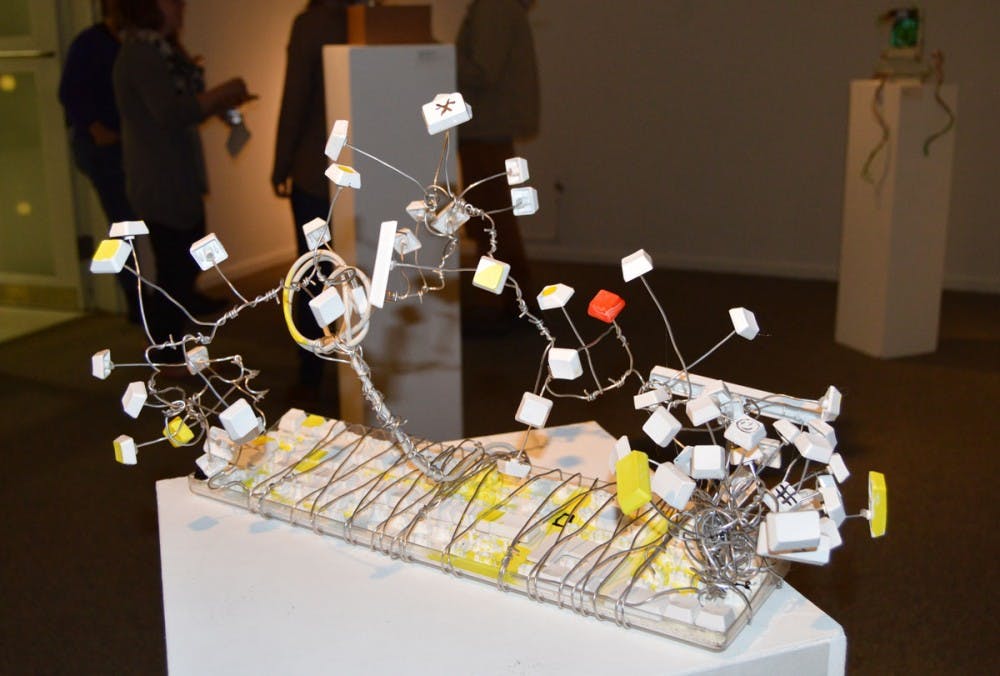Think twice before you throw out that dusty old computer keyboard – you just might be discarding a work of art.
This idea was what inspired Natalie Fleming, art resource curator and supervisor for the Lower Gallery at the Center for the Arts, to start the Cradle to Grave: Re-Appropriation, Obsolescence, and the Arts exhibition. Hosted in the Lower Gallery, the Cradle to Grave exhibit is now entering its third year of making creative statements from mundane objects that have outlived their usefulness.
“We like it as one of the first shows in the gallery space,” Fleming said. “It gives people a chance to relax and get creative.”
The concept of Cradle to Grave is simple: students select objects from a collection of “outdated” technology pre-assembled by the art department staff and somehow turn it into a creative work.
“The idea is that there’s so much that we throw away, that gets disregarded as technologies change – and we leave trash behind us,” Fleming said. “When I came to the department we had a lot in storage that wasn’t being used, and the idea of the show is to give these old and seemingly obsolete objects new life.”
Daniel Calleri, department technician of photography and curator installer of the Lower Gallery, said the exhibit is “a way to make people think about what they’re throwing out.”
Several pieces of Calleri’s artwork, including parts of a series on trash and food, were on display.
The work of Jenna Curran, a first year MFA student at UB, took on a very intimate tone. She said her evocative piece, Pulled Daisy II (Three Sisters), was not only about re-appropriating but it also had more weighty undertones.
“It’s the second in a study I did about suicide,” Curran said. “It’s about three sisters and one who committed suicide. I’ve been focusing a lot on birth and what happens to the body afterwards and the grieving process for those who are left.”
In its exploration of the relationship between the body and the earth, Curran’s work echoes the theme of the reclamation behind the Cradle to Grave exhibition.
“I started work that deals with humans form and floral imagery and reclaiming it,” she said.
Other pieces explored the theme of creative reclamation and re-appropriation in a different way, emphasizing the artistic potential of discarded technology.
While both 2D and 3D creations were on display, Cradle to Grave III included more sculptures than previous years.
Mary Ellen Bossert’s multimedia sculpture Monitor Lizard depicts a reptile bursting through the screen of an outdated computer monitor.
A piece by Mohammed Hossain called Mohamminator combines a painted human mask with computer hardware protruding from the back in place of a brain.
Compared to the first two exhibitions, this year’s Cradle to Grave also had an especially strong showing of submissions from outside UB.
“We have a lot of students involved from our neighboring universities,” Natalie Fleming said.
This year featured entries from Villa Maria College, Rochester Institute of Technology, SUNY Buffalo State and other institutions in Western New York.
Submissions were accepted from any interested artists, including non-UB students and professors.
“Artists have this special ability to reuse items that others don’t see the value of,” Fleming said. The art on display in the Lower Gallery proves her point.
Cradle to Grave III will run until November 7 and is open to the public.
email: arts@ubspectrum.com
Luke Heuskin is an arts staff writer. Arts desk can be reached at arts@ubspectrum.com.





